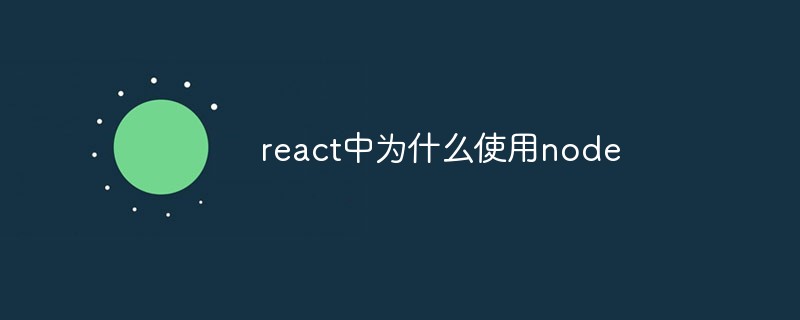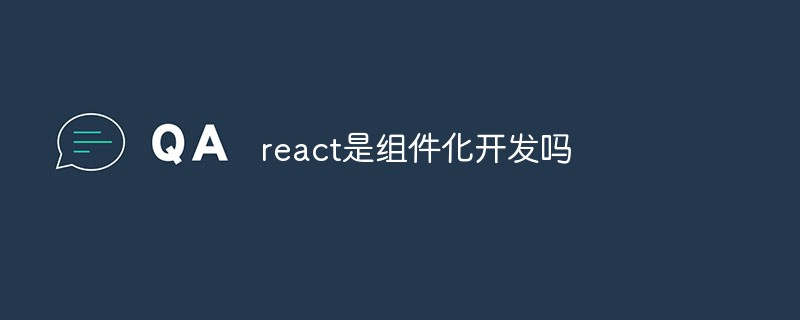这次给大家带来React组件的使用详解,使用React组件的注意事项有哪些,下面就是实战案例,一起来看一下。
当我刚开始写React的时候,我看过很多写组件的方法。一百篇教程就有一百种写法。虽然React本身已经成熟了,但是如何使用它似乎还没有一个“正确”的方法。所以我(作者)把我们团队这些年来总结的使用React的经验总结在这里。希望这篇文字对你有用,不管你是初学者还是老手。
开始前:
我们使用ES6、ES7语法如果你不是很清楚展示组件和容器组件的区别,建议您从阅读这篇文章开始如果您有任何的建议、疑问都清在评论里留言 基于类的组件
现在开发React组件一般都用的是基于类的组件。下面我们就来一行一样的编写我们的组件:
import React, { Component } from 'react';
import { observer } from 'mobx-react';
import ExpandableForm from './ExpandableForm';
import './styles/ProfileContainer.css';
我很喜欢css in javascript。但是,这个写样式的方法还是太新了。所以我们在每个组件里引入css文件。而且本地引入的import和全局的import会用一个空行来分割。
初始化State
import React, { Component } from 'react'
import { observer } from 'mobx-react'
import ExpandableForm from './ExpandableForm'
import './styles/ProfileContainer.css'
export default class ProfileContainer extends Component {
state = { expanded: false }
您可以使用了老方法在constructor里初始化state。更多相关可以看这里。但是我们选择更加清晰的方法。
同时,我们确保在类前面加上了export default。(译者注:虽然这个在使用了redux的时候不一定对)。
propTypes and defaultProps
import React, { Component } from 'react'
import { observer } from 'mobx-react'
import { string, object } from 'prop-types'
import ExpandableForm from './ExpandableForm'
import './styles/ProfileContainer.css'
export default class ProfileContainer extends Component {
state = { expanded: false }
static propTypes = {
model: object.isRequired,
title: string
}
static defaultProps = {
model: {
id: 0
},
title: 'Your Name'
}
// ...
}
propTypes和defaultProps是静态属性。尽可能在组件类的的前面定义,让其他的开发人员读代码的时候可以立刻注意到。他们可以起到文档的作用。
如果你使用了React 15.3.0或者更高的版本,那么需要另外引入prop-types包,而不是使用React.PropTypes。更多内容移步这里。
你所有的组件都应该有prop types。
方法
import React, { Component } from 'react'
import { observer } from 'mobx-react'
import { string, object } from 'prop-types'
import ExpandableForm from './ExpandableForm'
import './styles/ProfileContainer.css'
export default class ProfileContainer extends Component {
state = { expanded: false }
static propTypes = {
model: object.isRequired,
title: string
}
static defaultProps = {
model: {
id: 0
},
title: 'Your Name'
}
handleSubmit = (e) => {
e.preventDefault()
this.props.model.save()
}
handleNameChange = (e) => {
this.props.model.changeName(e.target.value)
}
handleExpand = (e) => {
e.preventDefault()
this.setState({ expanded: !this.state.expanded })
}
// ...
}
在类组件里,当你把方法传递给子组件的时候,需要确保他们被调用的时候使用的是正确的this。一般都会在传给子组件的时候这么做:this.handleSubmit.bind(this)。
使用ES6的箭头方法就简单多了。它会自动维护正确的上下文(this)。
给setState传入一个方法
在上面的例子里有这么一行:
this.setState({ expanded: !this.state.expanded });
setState其实是异步的!React为了提高性能,会把多次调用的setState放在一起调用。所以,调用了setState之后state不一定会立刻就发生改变。
所以,调用setState的时候,你不能依赖于当前的state值。因为i根本不知道它是值会是神马。
解决方法:给setState传入一个方法,把调用前的state值作为参数传入这个方法。看看例子:
this.setState(prevState => ({ expanded: !prevState.expanded }))
感谢Austin Wood的帮助。
拆解组件
import React, { Component } from 'react'
import { observer } from 'mobx-react'
import { string, object } from 'prop-types'
import ExpandableForm from './ExpandableForm'
import './styles/ProfileContainer.css'
export default class ProfileContainer extends Component {
state = { expanded: false }
static propTypes = {
model: object.isRequired,
title: string
}
static defaultProps = {
model: {
id: 0
},
title: 'Your Name'
}
handleSubmit = (e) => {
e.preventDefault()
this.props.model.save()
}
handleNameChange = (e) => {
this.props.model.changeName(e.target.value)
}
handleExpand = (e) => {
e.preventDefault()
this.setState(prevState => ({ expanded: !prevState.expanded }))
}
render() {
const {
model,
title
} = this.props
return (
{title}
)
}
}
有多行的props的,每一个prop都应该单独占一行。就如上例一样。要达到这个目标最好的方法是使用一套工具:Prettier。
装饰器(Decorator)
@observer
export default class ProfileContainer extends Component {
如果你了解某些库,比如mobx,你就可以使用上例的方式来修饰类组件。装饰器就是把类组件作为一个参数传入了一个方法。
装饰器可以编写更灵活、更有可读性的组件。如果你不想用装饰器,你可以这样:
class ProfileContainer extends Component {
// Component code
}
export default observer(ProfileContainer)
闭包
尽量避免在子组件中传入闭包,如:
<input
type="text"
value={model.name}
// onChange={(e) => { model.name = e.target.value }}
// ^ Not this. Use the below:
onChange={this.handleChange}
placeholder="Your Name"/>
注意:如果input是一个React组件的话,这样自动触发它的重绘,不管其他的props是否发生了改变。
一致性检验是React最消耗资源的部分。不要把额外的工作加到这里。处理上例中的问题最好的方法是传入一个类方法,这样还会更加易读,更容易调试。如:
import React, { Component } from 'react'
import { observer } from 'mobx-react'
import { string, object } from 'prop-types'
// Separate local imports from dependencies
import ExpandableForm from './ExpandableForm'
import './styles/ProfileContainer.css'
// Use decorators if needed
@observer
export default class ProfileContainer extends Component {
state = { expanded: false }
// Initialize state here (ES7) or in a constructor method (ES6)
// Declare propTypes as static properties as early as possible
static propTypes = {
model: object.isRequired,
title: string
}
// Default props below propTypes
static defaultProps = {
model: {
id: 0
},
title: 'Your Name'
}
// Use fat arrow functions for methods to preserve context (this will thus be the component instance)
handleSubmit = (e) => {
e.preventDefault()
this.props.model.save()
}
handleNameChange = (e) => {
this.props.model.name = e.target.value
}
handleExpand = (e) => {
e.preventDefault()
this.setState(prevState => ({ expanded: !prevState.expanded }))
}
render() {
// Destructure props for readability
const {
model,
title
} = this.props
return (
// Newline props if there are more than two
{title}
{ model.name = e.target.value }}
// Avoid creating new closures in the render method- use methods like below
onChange={this.handleNameChange}
placeholder="Your Name"/>
)
}
}
方法组件
这类组件没有state没有props,也没有方法。它们是纯组件,包含了最少的引起变化的内容。经常使用它们。
propTypes
import React from 'react'
import { observer } from 'mobx-react'
import { func, bool } from 'prop-types'
import './styles/Form.css'
ExpandableForm.propTypes = {
onSubmit: func.isRequired,
expanded: bool
}
// Component declaration
我们在组件的声明之前就定义了propTypes。
分解Props和defaultProps
import React from 'react'
import { observer } from 'mobx-react'
import { func, bool } from 'prop-types'
import './styles/Form.css'
ExpandableForm.propTypes = {
onSubmit: func.isRequired,
expanded: bool,
onExpand: func.isRequired
}
function ExpandableForm(props) {
const formStyle = props.expanded ? {height: 'auto'} : {height: 0}
return (
<form style={formStyle} onSubmit={props.onSubmit}>
{props.children}
<button onClick={props.onExpand}>Expand</button>
</form>
)
}
我们的组件是一个方法。它的参数就是props。我们可以这样扩展这个组件:
import React from 'react'
import { observer } from 'mobx-react'
import { func, bool } from 'prop-types'
import './styles/Form.css'
ExpandableForm.propTypes = {
onSubmit: func.isRequired,
expanded: bool,
onExpand: func.isRequired
}
function ExpandableForm({ onExpand, expanded = false, children, onSubmit }) {
const formStyle = expanded ? {height: 'auto'} : {height: 0}
return (
<form style={formStyle} onSubmit={onSubmit}>
{children}
<button onClick={onExpand}>Expand</button>
</form>
)
}
现在我们也可以使用默认参数来扮演默认props的角色,这样有很好的可读性。如果expanded没有定义,那么我们就把它设置为false。
但是,尽量避免使用如下的例子:
const ExpandableForm = ({ onExpand, expanded, children }) => {
看起来很现代,但是这个方法是未命名的。
如果你的Babel配置正确,未命名的方法并不会是什么大问题。但是,如果Babel有问题的话,那么这个组件里的任何错误都显示为发生在 <>里的,这调试起来就非常麻烦了。
匿名方法也会引起Jest其他的问题。由于会引起各种难以理解的问题,而且也没有什么实际的好处。我们推荐使用function,少使用const。
装饰方法组件
由于方法组件没法使用装饰器,只能把它作为参数传入别的方法里。
import React from 'react'
import { observer } from 'mobx-react'
import { func, bool } from 'prop-types'
import './styles/Form.css'
ExpandableForm.propTypes = {
onSubmit: func.isRequired,
expanded: bool,
onExpand: func.isRequired
}
function ExpandableForm({ onExpand, expanded = false, children, onSubmit }) {
const formStyle = expanded ? {height: 'auto'} : {height: 0}
return (
<form style={formStyle} onSubmit={onSubmit}>
{children}
<button onClick={onExpand}>Expand</button>
</form>
)
}
export default observer(ExpandableForm)
只能这样处理:export default observer(ExpandableForm)。
这就是组件的全部代码:
import React from 'react'
import { observer } from 'mobx-react'
import { func, bool } from 'prop-types'
// Separate local imports from dependencies
import './styles/Form.css'
// Declare propTypes here, before the component (taking advantage of JS function hoisting)
// You want these to be as visible as possible
ExpandableForm.propTypes = {
onSubmit: func.isRequired,
expanded: bool,
onExpand: func.isRequired
}
// Destructure props like so, and use default arguments as a way of setting defaultProps
function ExpandableForm({ onExpand, expanded = false, children, onSubmit }) {
const formStyle = expanded ? { height: 'auto' } : { height: 0 }
return (
<form style={formStyle} onSubmit={onSubmit}>
{children}
<button onClick={onExpand}>Expand</button>
</form>
)
}
// Wrap the component instead of decorating it
export default observer(ExpandableForm)
某些情况下,你会做很多的条件判断:
<p id="lb-footer">
{props.downloadMode && currentImage && !currentImage.video && currentImage.blogText
? !currentImage.submitted && !currentImage.posted
? <p>Please contact us for content usage</p>
: currentImage && currentImage.selected
? <button onClick={props.onSelectImage} className="btn btn-selected">Deselect</button>
: currentImage && currentImage.submitted
? <button className="btn btn-submitted" disabled>Submitted</button>
: currentImage && currentImage.posted
? <button className="btn btn-posted" disabled>Posted</button>
: <button onClick={props.onSelectImage} className="btn btn-unselected">Select post</button>
}
</p>
这么多层的条件判断可不是什么好现象。
有第三方库JSX-Control Statements可以解决这个问题。但是与其增加一个依赖,还不如这样来解决:
<p id="lb-footer">
{
(() => {
if(downloadMode && !videoSrc) {
if(isApproved && isPosted) {
return <p>Right click image and select "Save Image As.." to download</p>
} else {
return <p>Please contact us for content usage</p>
}
}
// ...
})()
}
</p>
相信看了本文案例你已经掌握了方法,更多精彩请关注php中文网其它相关文章!
推荐阅读:
以上是React组件的使用详解的详细内容。更多信息请关注PHP中文网其他相关文章!
 react中canvas的用法是什么Apr 27, 2022 pm 03:12 PM
react中canvas的用法是什么Apr 27, 2022 pm 03:12 PM在react中,canvas用于绘制各种图表、动画等;可以利用“react-konva”插件使用canvas,该插件是一个canvas第三方库,用于使用React操作canvas绘制复杂的画布图形,并提供了元素的事件机制和拖放操作的支持。
 react中antd和dva是什么意思Apr 21, 2022 pm 03:25 PM
react中antd和dva是什么意思Apr 21, 2022 pm 03:25 PM在react中,antd是基于Ant Design的React UI组件库,主要用于研发企业级中后台产品;dva是一个基于redux和“redux-saga”的数据流方案,内置了“react-router”和fetch,可理解为应用框架。
 React是双向数据流吗Apr 21, 2022 am 11:18 AM
React是双向数据流吗Apr 21, 2022 am 11:18 AMReact不是双向数据流,而是单向数据流。单向数据流是指数据在某个节点被改动后,只会影响一个方向上的其他节点;React中的表现就是数据主要通过props从父节点传递到子节点,若父级的某个props改变了,React会重渲染所有子节点。
 react中为什么使用nodeApr 21, 2022 am 10:34 AM
react中为什么使用nodeApr 21, 2022 am 10:34 AM因为在react中需要利用到webpack,而webpack依赖nodejs;webpack是一个模块打包机,在执行打包压缩的时候是依赖nodejs的,没有nodejs就不能使用webpack,所以react需要使用nodejs。
 react中forceupdate的用法是什么Apr 19, 2022 pm 12:03 PM
react中forceupdate的用法是什么Apr 19, 2022 pm 12:03 PM在react中,forceupdate()用于强制使组件跳过shouldComponentUpdate(),直接调用render(),可以触发组件的正常生命周期方法,语法为“component.forceUpdate(callback)”。
 react是组件化开发吗Apr 22, 2022 am 10:44 AM
react是组件化开发吗Apr 22, 2022 am 10:44 AMreact是组件化开发;组件化是React的核心思想,可以开发出一个个独立可复用的小组件来构造应用,任何的应用都会被抽象成一颗组件树,组件化开发也就是将一个页面拆分成一个个小的功能模块,每个功能完成自己这部分独立功能。
 react和reactdom有什么区别Apr 27, 2022 am 10:26 AM
react和reactdom有什么区别Apr 27, 2022 am 10:26 AMreact和reactdom的区别是:ReactDom只做和浏览器或DOM相关的操作,例如“ReactDOM.findDOMNode()”操作;而react负责除浏览器和DOM以外的相关操作,ReactDom是React的一部分。
 react与vue的虚拟dom有什么区别Apr 22, 2022 am 11:11 AM
react与vue的虚拟dom有什么区别Apr 22, 2022 am 11:11 AMreact与vue的虚拟dom没有区别;react和vue的虚拟dom都是用js对象来模拟真实DOM,用虚拟DOM的diff来最小化更新真实DOM,可以减小不必要的性能损耗,按颗粒度分为不同的类型比较同层级dom节点,进行增、删、移的操作。


热AI工具

Undresser.AI Undress
人工智能驱动的应用程序,用于创建逼真的裸体照片

AI Clothes Remover
用于从照片中去除衣服的在线人工智能工具。

Undress AI Tool
免费脱衣服图片

Clothoff.io
AI脱衣机

AI Hentai Generator
免费生成ai无尽的。

热门文章

热工具

Dreamweaver CS6
视觉化网页开发工具

禅工作室 13.0.1
功能强大的PHP集成开发环境

EditPlus 中文破解版
体积小,语法高亮,不支持代码提示功能

SublimeText3 英文版
推荐:为Win版本,支持代码提示!

ZendStudio 13.5.1 Mac
功能强大的PHP集成开发环境






